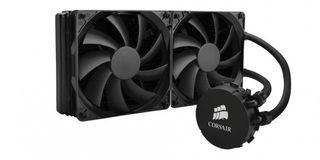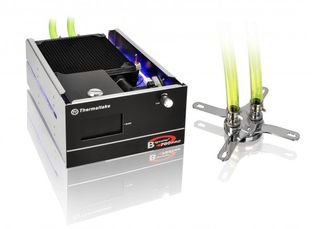Corsair and Thermaltake supersize their liquid chip-chillers

In keeping with the wintery theme of today (my Bath office is looking like a snowy scene from a Dickens classic, there's even an urchin or two out there) Thermaltake and and Corsair want to help you keep cold and have both announced liquid-based CPU coolers with extra-chunky radiators.
Corsair's new H110 and H90 coolers are essentially just slightly larger versions of their H100 and H80, with 280mm and 140mm radiators respectively. The original versions came with 240mm and 120mm radiators, both operating using 120mm fans.
The new H110 and H80 both use the larger 140mm fans, and that means they don't need to spin as fast to shift the same amount of air across the radiators. And what does slow spin speed mean? Yes, quieter operation.
They should both be available soon with the H110 available for $130 and the H90 for $100. In the UK I would expect that to translate to around £100 and £70 respectively if you shop around.
Thermaltake though have announced something even more exciting. Mainly because it's got such a cool name - the Bigwater 760 Pro.

Rather than having a reservoir/radiator you attach to the exhaust ports of your chassis - with a pump connected to the CPU waterblock - the Bigwater 760 Pro is more like the water-cooling arrays of old.
The whole pump, reservoir and radiator array are designed to be installed in the front of your chassis, taking up two empty 5.25-inch drive bays. Now that I've quit installing optical drives in my machines that's a sacrifice I'm willing to make.
The biggest gaming news, reviews and hardware deals
Keep up to date with the most important stories and the best deals, as picked by the PC Gamer team.
It means the water-cooler actually takes up almost no space in the chassis itself, but does mean the warm air is being exhausting inside the case. You'll need to ensure then that there's an adequate through-flow of air to keep things cool.
One other bonus from this separate pump setup is that it can be expanded, something you can't do with traditional, closed-loop coolers. That means you can add a waterblock to your graphics card and add that into the liquid-cooling loop too.

Dave has been gaming since the days of Zaxxon and Lady Bug on the Colecovision, and code books for the Commodore Vic 20 (Death Race 2000!). He built his first gaming PC at the tender age of 16, and finally finished bug-fixing the Cyrix-based system around a year later. When he dropped it out of the window. He first started writing for Official PlayStation Magazine and Xbox World many decades ago, then moved onto PC Format full-time, then PC Gamer, TechRadar, and T3 among others. Now he's back, writing about the nightmarish graphics card market, CPUs with more cores than sense, gaming laptops hotter than the sun, and SSDs more capacious than a Cybertruck.
Most Popular

